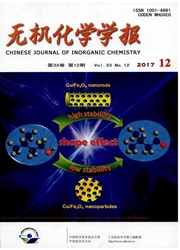

 中文摘要:
中文摘要:
本论文采用阳极氧化法在金属钛基底上制备高度有序的TiO2纳米管阵列薄膜.然后采用脉冲电流法在TiO2纳米管阵列上沉积Cu2O,从而制备出Cu2O-TiO2纳米管阵列异质结复合薄膜。借助X射线衍射仪(XRD),场发射扫描电子显微镜(FESEM)和透射电子显微镜(TEM)等表征手段,详细探讨了Cu2O沉积过程中电解液的不同扰动方式(静止、磁力搅拌和超声搅拌)对复合薄膜物相和形貌的影响。实验结果表明电解液的扰动方式会影响Cu2O沉积过程中的离子扩散和微区化学环境.从而影响Cu2O的形貌。通过漫反射紫外-可见吸收光谱(UV-Vis)和光电流性能测试可知所制备的负载Cu2O型TiO2纳米管阵列薄膜具有显著的可见光响应效应。
 英文摘要:
英文摘要:
The highly ordered TiO2 nanotube arrays films were fabricated by anodic oxidation of titanium foil substrates. And then, Cu2O particles were loaded on TiO2 nanotube arrays via galvanostatic pulse electrodeposition. As a result, Cu2O-TiO2 nanotube arrays heterojunction composite films were obtained. The influence of the electrolyte agitation methods (standing, magnetic agitating and ultrasonic stirring) during the processing of depositing Cu2O on the morphology and microstructure of the composite films were investigated by X-ray diffraction (XRD), field emitting scanning electron microscopy (FESEM) and transmission electron microscopy(TEM). The results show that the electrolyte agitation methods would affect the ion diffussion and local chemical environment in the processing of depositing Cu2O, which results in the morphologies evolution of Cu2O particles. The diffuse reflectance UV-Vis absorption spectra and the photocurrent properties measurements show that the prepared Cu2O-TiO2 nanotube arrays composite films exhibit remarkable visible light responses under visible light illumination.
 同期刊论文项目
同期刊论文项目
 同项目期刊论文
同项目期刊论文
 A novel testing approach for interfacial normal bond strength of thin laminated metallic composite p
A novel testing approach for interfacial normal bond strength of thin laminated metallic composite p 期刊信息
期刊信息
